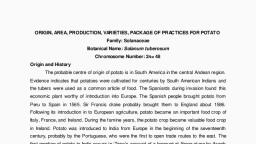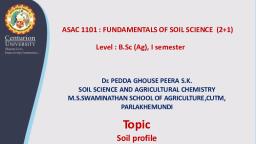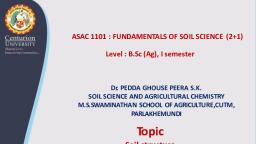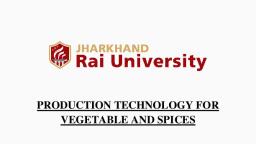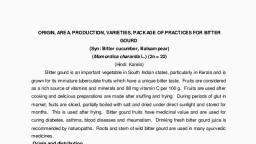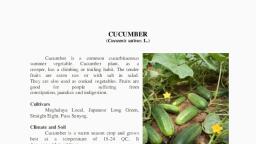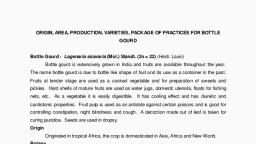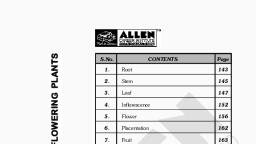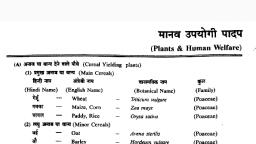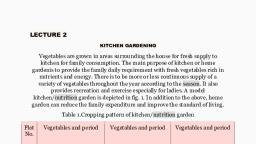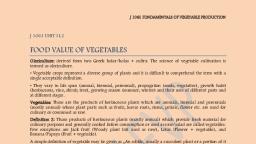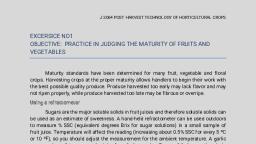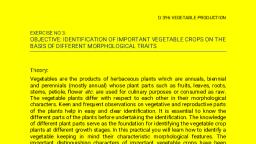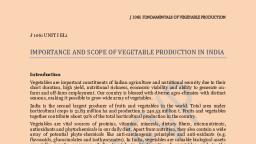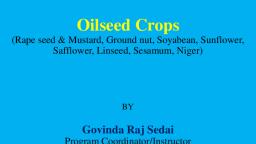Page 1 :
LECTURE 3, Classification of vegetable crops, INTRODUCTION, •, , There are more than 240 plants in the world which are used as vegetables. Hence,, their classification is essential to understand the nature of vegetable crops and, their commonness or distinctness requirement for commercial production. The, classification is mainly to show the relationship between the individual vegetables, and to avoid repetition while describing their cultural operations. Any method of, classification systematizes to some extent the preparation and presentation of the, material and eliminates unnecessary repetition of some of the principles of culture., , •, , Vegetable crops have been classified into various groups, but the classification, based on the cultural practices has been proved to be the best adoptable in the field, conditions, since it is very convenient to a growers. No single method of, classification would serve the purpose for different groups like agronomists,, breeders, taxonomists and so on. For convenience the following methods of, classification are suggested., I., , Botanical classification:, , Botanical classification is based on taxonomical relationship among different vegetables. Plant kingdom, is divided into four viz. Thallophyta, Bryophyta, Pteriodophyta and Spermatophyte. All vegetables, belong to division Angiospermae of Spermatophyta. It is further divided into two classes viz.,, Monocotyledoneae and dicotyledoneae., The family wise distribution of vegetables under the classes is as follows:, Monocotyledoneae, Family Alliaceae, Allium cepa, Allium cepa var. Aggregatum, Allium cepa var. Viviparum, Allium porrum, Allium sativum, Allium fistulosum, Allium ascalonicum, Allium schoenoprasum, Family Liliaceae, Asparagus officinalis, Family Araceae, Dioscorea alata, Dioscorea esculenta, Colocasia esculenta, Family Poaceae (Graminae), Zea mays, Dicotyledoneae, , Onion, Multiplier onion, Top onion, Leek, Garlic, Welsh onion, Shallot, Chive, Asparagus, Larger yam, Lesser yam, Taro, Sweet corn
Page 4 :
III. Method of culture :, By this method it is possible to generalize the cultivation practices based on their culture, and climatic requirements., , Sl., No., , Group, , Vegetables, , 1, , Perennial, vegetables, , Asparagus, Artichoke, Chow chow, Moringa, Ivy, guard, Pointed gourd, Spine gourd, , 2, , Greens, , Spinach, New Zealand spinach, Kale, Chard,, Mustard, Collards, Amaranthus, , 3, , Salad crops, , Celery, Lettuce, Cress, Parsley, , 4, , Cole crops, , Cabbage, Cauliflower, Broccoli, Brussel’s sprout, Chinese cabbage, Knol-khol, , 5, , Root crops, , Beet root, Carrot, Parsnip, Turnip, Raddish, , 6, , Bulb crops, , Onion, Leek, Garlic, Shallot, Welsh Onion, Chive, , 7, , Tuber crops, , Potato, Sweet potato, Cassava, Elephant foot yam, , 8, , Peas and beans, , Pea, Bean, Broad bean, Lima bean, Winged bean,, Cowpea, , 9, , Solanaceous, crops, , 10, , Cucurbits, , Tomato, Brinjal, Chilli, Pepper, , Cucumber, Watermelon, Pumpkin, Gourds
Page 5 :
11, , Fibre crop, , Okra, , 12, , Pot herbs green, , Spinach, Kale, , 13, , Other root crops, , Colocasia, Dioscorea, Arrow root, , IV. Life cycle:, Annuals: Vegetables which complete their life cycle in one season. Eg: Broad bean, Lima bean, Water melon, Musk, melon, Indian spinach, Chinese cabbage, Cress etc., Biennial: Those végétales which complète their life cycle in two seasons., Eg. Cabbage, cauliflower, turnip, carrot, etc.,, Perennial: Those végétales which complète their life cycle in more than two seasons., Eg. Artichoke, chicory, asparagus, chow chow, coccinia etc.,, , V. Thermo classification:, On the basis of temperature, vegetable crops may be grouped into cool and warm season crops., In cool season crops, the edible parts are mainly root, stem, leaf and immature flower parts., Whereas, in warm season crops edible part is mainly fruit with exception of pea and broad bean, which are cool season crops. The cool season crops grow well when the monthly mean, temperature does not exceed 210 C. They thrive best if the monthly mean temperature is 15170 C. The warm season crops on the other hand grow best when the monthly mean and, average maximum temperature are 50 to 60C higher than for the cool season crops. The, average monthly minimum temperature should not be below 90C to 100C for the, warm season crops., •, , Cool season vegetable crops, , Warm season vegetable crops, , Cole crops, , Beans(mostly), , Root crops, , Solanaceous vegetables
Page 6 :
Bulb crops, , Gourds, , Lettuce, , Okra, , Methi, , Cassava, , Pea, , Summer squash, , Potato, , Sweet potato, , Winter squash, , Yam, , VI. Photoperiod:, Short day vegetables: Soybean, Sweet potato, Long day vegetables: Flowering is induced by period longer than critical units. eg;, Spinach, beet, Chinese cabbage, Lettuce, Radish etc., Day neutral vegetables: Flowerings induced by a period of 10-18 hours of even continuous, illumination. eg: Tomato, Squash, Pumpkin, Asparagus, Pepper etc.

